An Analysis of Youths and Employment in a Changing Economy
VerifiedAdded on 2020/12/22
|12
|3163
|55
Report
AI Summary
This report analyzes the challenges faced by young people in the labor market, focusing on the decline in union membership and the rise of precarious work conditions. It begins by reviewing existing literature on the topic, highlighting the impact of the 2008 financial crisis and the shift towards flexible capitalism. The report examines the attitudes of young workers towards unions, contrasting them with older generations and exploring the structural factors that contribute to lower unionization rates among youth. It discusses the impact of non-standard employment and the prevalence of low-skill service professions on young workers. The report also explores the importance of job security for young people, and examines measures to address youth unemployment, emphasizing the role of governments and unions in promoting youth inclusion in the job market.
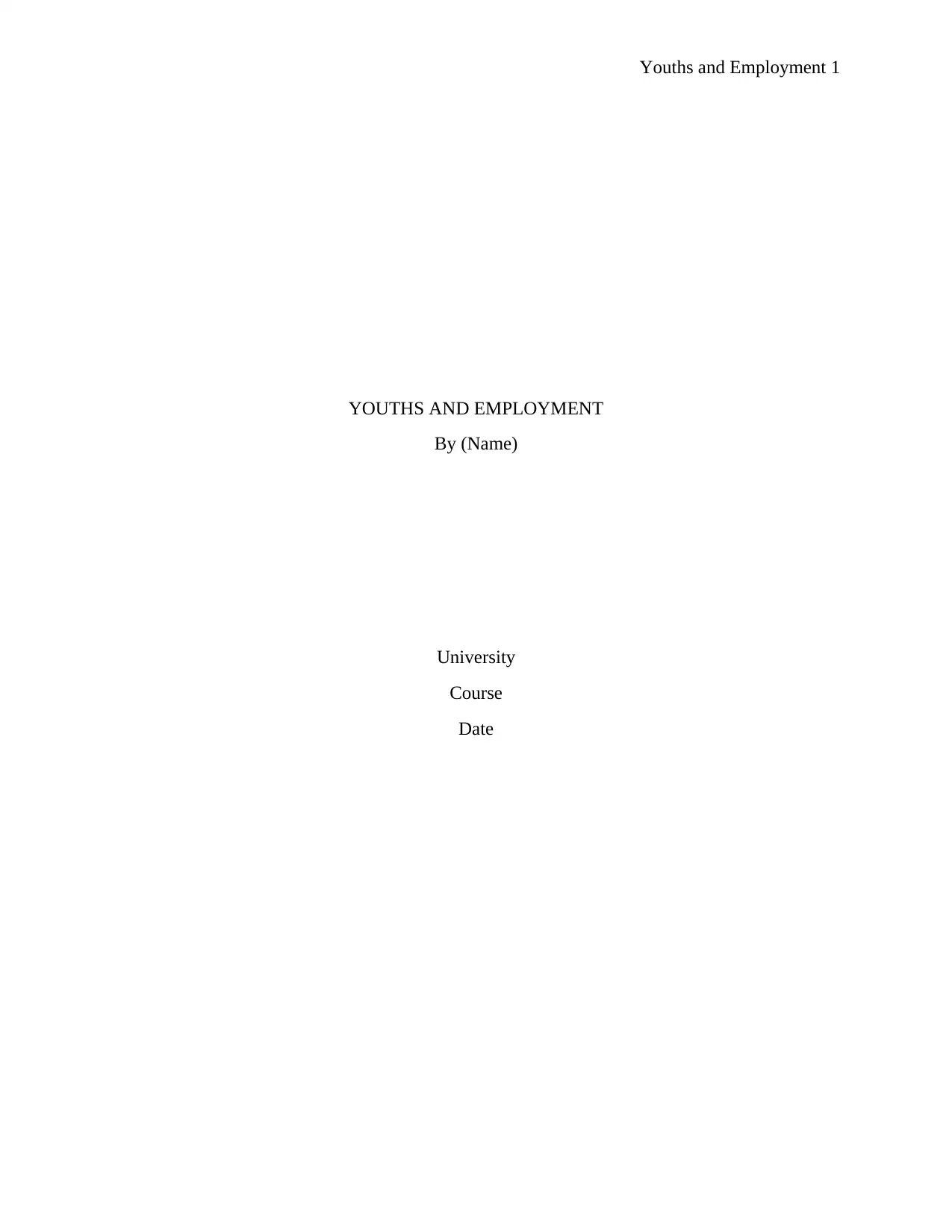
Youths and Employment 1
YOUTHS AND EMPLOYMENT
By (Name)
University
Course
Date
YOUTHS AND EMPLOYMENT
By (Name)
University
Course
Date
Paraphrase This Document
Need a fresh take? Get an instant paraphrase of this document with our AI Paraphraser
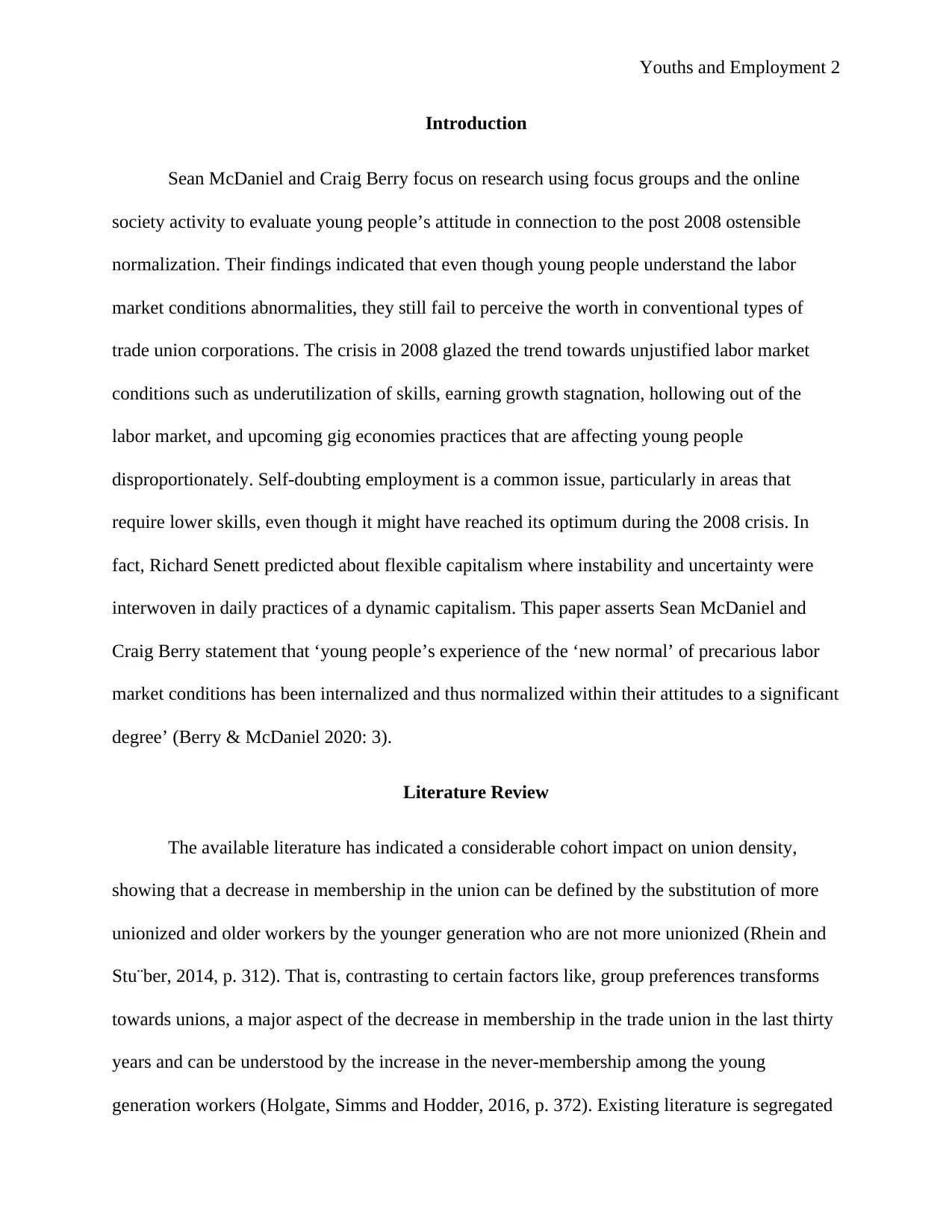
Youths and Employment 2
Introduction
Sean McDaniel and Craig Berry focus on research using focus groups and the online
society activity to evaluate young people’s attitude in connection to the post 2008 ostensible
normalization. Their findings indicated that even though young people understand the labor
market conditions abnormalities, they still fail to perceive the worth in conventional types of
trade union corporations. The crisis in 2008 glazed the trend towards unjustified labor market
conditions such as underutilization of skills, earning growth stagnation, hollowing out of the
labor market, and upcoming gig economies practices that are affecting young people
disproportionately. Self-doubting employment is a common issue, particularly in areas that
require lower skills, even though it might have reached its optimum during the 2008 crisis. In
fact, Richard Senett predicted about flexible capitalism where instability and uncertainty were
interwoven in daily practices of a dynamic capitalism. This paper asserts Sean McDaniel and
Craig Berry statement that ‘young people’s experience of the ‘new normal’ of precarious labor
market conditions has been internalized and thus normalized within their attitudes to a significant
degree’ (Berry & McDaniel 2020: 3).
Literature Review
The available literature has indicated a considerable cohort impact on union density,
showing that a decrease in membership in the union can be defined by the substitution of more
unionized and older workers by the younger generation who are not more unionized (Rhein and
Stu¨ber, 2014, p. 312). That is, contrasting to certain factors like, group preferences transforms
towards unions, a major aspect of the decrease in membership in the trade union in the last thirty
years and can be understood by the increase in the never-membership among the young
generation workers (Holgate, Simms and Hodder, 2016, p. 372). Existing literature is segregated
Introduction
Sean McDaniel and Craig Berry focus on research using focus groups and the online
society activity to evaluate young people’s attitude in connection to the post 2008 ostensible
normalization. Their findings indicated that even though young people understand the labor
market conditions abnormalities, they still fail to perceive the worth in conventional types of
trade union corporations. The crisis in 2008 glazed the trend towards unjustified labor market
conditions such as underutilization of skills, earning growth stagnation, hollowing out of the
labor market, and upcoming gig economies practices that are affecting young people
disproportionately. Self-doubting employment is a common issue, particularly in areas that
require lower skills, even though it might have reached its optimum during the 2008 crisis. In
fact, Richard Senett predicted about flexible capitalism where instability and uncertainty were
interwoven in daily practices of a dynamic capitalism. This paper asserts Sean McDaniel and
Craig Berry statement that ‘young people’s experience of the ‘new normal’ of precarious labor
market conditions has been internalized and thus normalized within their attitudes to a significant
degree’ (Berry & McDaniel 2020: 3).
Literature Review
The available literature has indicated a considerable cohort impact on union density,
showing that a decrease in membership in the union can be defined by the substitution of more
unionized and older workers by the younger generation who are not more unionized (Rhein and
Stu¨ber, 2014, p. 312). That is, contrasting to certain factors like, group preferences transforms
towards unions, a major aspect of the decrease in membership in the trade union in the last thirty
years and can be understood by the increase in the never-membership among the young
generation workers (Holgate, Simms and Hodder, 2016, p. 372). Existing literature is segregated
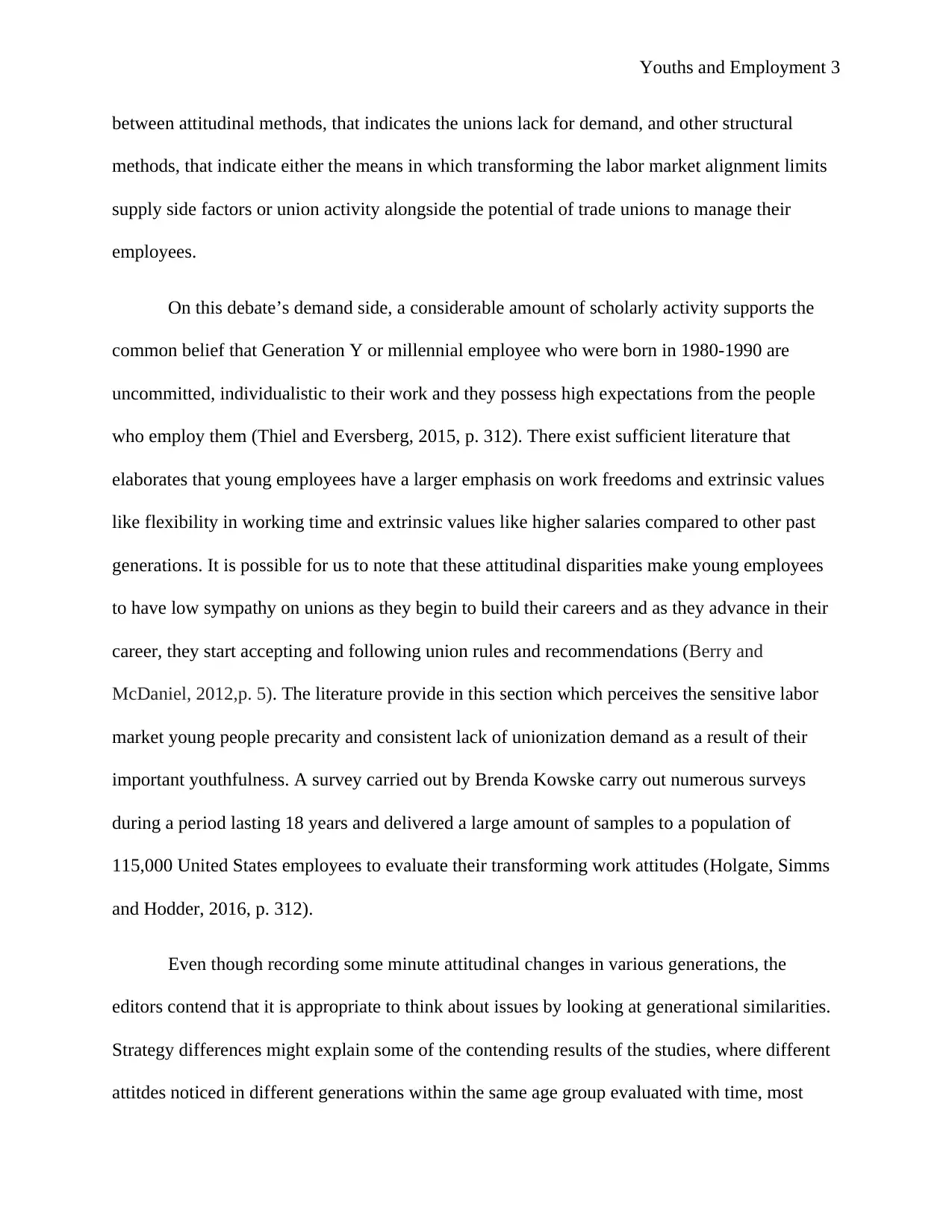
Youths and Employment 3
between attitudinal methods, that indicates the unions lack for demand, and other structural
methods, that indicate either the means in which transforming the labor market alignment limits
supply side factors or union activity alongside the potential of trade unions to manage their
employees.
On this debate’s demand side, a considerable amount of scholarly activity supports the
common belief that Generation Y or millennial employee who were born in 1980-1990 are
uncommitted, individualistic to their work and they possess high expectations from the people
who employ them (Thiel and Eversberg, 2015, p. 312). There exist sufficient literature that
elaborates that young employees have a larger emphasis on work freedoms and extrinsic values
like flexibility in working time and extrinsic values like higher salaries compared to other past
generations. It is possible for us to note that these attitudinal disparities make young employees
to have low sympathy on unions as they begin to build their careers and as they advance in their
career, they start accepting and following union rules and recommendations (Berry and
McDaniel, 2012,p. 5). The literature provide in this section which perceives the sensitive labor
market young people precarity and consistent lack of unionization demand as a result of their
important youthfulness. A survey carried out by Brenda Kowske carry out numerous surveys
during a period lasting 18 years and delivered a large amount of samples to a population of
115,000 United States employees to evaluate their transforming work attitudes (Holgate, Simms
and Hodder, 2016, p. 312).
Even though recording some minute attitudinal changes in various generations, the
editors contend that it is appropriate to think about issues by looking at generational similarities.
Strategy differences might explain some of the contending results of the studies, where different
attitdes noticed in different generations within the same age group evaluated with time, most
between attitudinal methods, that indicates the unions lack for demand, and other structural
methods, that indicate either the means in which transforming the labor market alignment limits
supply side factors or union activity alongside the potential of trade unions to manage their
employees.
On this debate’s demand side, a considerable amount of scholarly activity supports the
common belief that Generation Y or millennial employee who were born in 1980-1990 are
uncommitted, individualistic to their work and they possess high expectations from the people
who employ them (Thiel and Eversberg, 2015, p. 312). There exist sufficient literature that
elaborates that young employees have a larger emphasis on work freedoms and extrinsic values
like flexibility in working time and extrinsic values like higher salaries compared to other past
generations. It is possible for us to note that these attitudinal disparities make young employees
to have low sympathy on unions as they begin to build their careers and as they advance in their
career, they start accepting and following union rules and recommendations (Berry and
McDaniel, 2012,p. 5). The literature provide in this section which perceives the sensitive labor
market young people precarity and consistent lack of unionization demand as a result of their
important youthfulness. A survey carried out by Brenda Kowske carry out numerous surveys
during a period lasting 18 years and delivered a large amount of samples to a population of
115,000 United States employees to evaluate their transforming work attitudes (Holgate, Simms
and Hodder, 2016, p. 312).
Even though recording some minute attitudinal changes in various generations, the
editors contend that it is appropriate to think about issues by looking at generational similarities.
Strategy differences might explain some of the contending results of the studies, where different
attitdes noticed in different generations within the same age group evaluated with time, most
⊘ This is a preview!⊘
Do you want full access?
Subscribe today to unlock all pages.

Trusted by 1+ million students worldwide

Youths and Employment 4
likely to vary on the belief that the young people today are usually varied compared to the older
adults (Tapia and Turner, 2018, p. 391). An analysis of the facts presented by Jenifer Deal and
her counterparts indicate that most research activities show little statistical disparities, but the
disparities are modest and few at best and there exist no evidence of the sweeping differences
forms in orientations, attitudes, and work ethics that the popular press is populated with.
The differences in positive attitudes amongst young workers towards unions and the low
rate of unionization among them can be well understood by looking at the structure of the labor
market. This means that the rates of youth employment is usually lower compared to the whole
working population, while the ones who are working are disadvantaged by low quality job
positions and crowing at their places of work which has lowered the availability of trade unions.
Young employees usually work in segments that are not fully covered by membership in the
union, collective bargaining and union representation (International Social Survey Programme,
2015, p. 21). The differences between adult workers and young adults in terms of union density
mostly is as a result of factors found in the labor market which bring about constraints in the
supply side, like absence of representation union demand per person and absence of workplace
information on why or how one should be a member to a certain union.
Usually, structural accounts on the vitality of dynamic labor market conditions, together
with large scale time-drag studies on attitude, refute strongly proposals that the young people in
our current community are somehow different in accepting trade unions compared to the older
generation. But in the structural contentions show the available weaknesses of methods used to
study attitude, from a theoretical viewpoint is vital to keep a thoughtful consideration of the
association between this two (Otto-Brenner Stiftung, OBS-Arbeitsheft and Heery, 2012, p. 27).
The structural-attitudinal contradiction in this literature should not restrict a conversation of the
likely to vary on the belief that the young people today are usually varied compared to the older
adults (Tapia and Turner, 2018, p. 391). An analysis of the facts presented by Jenifer Deal and
her counterparts indicate that most research activities show little statistical disparities, but the
disparities are modest and few at best and there exist no evidence of the sweeping differences
forms in orientations, attitudes, and work ethics that the popular press is populated with.
The differences in positive attitudes amongst young workers towards unions and the low
rate of unionization among them can be well understood by looking at the structure of the labor
market. This means that the rates of youth employment is usually lower compared to the whole
working population, while the ones who are working are disadvantaged by low quality job
positions and crowing at their places of work which has lowered the availability of trade unions.
Young employees usually work in segments that are not fully covered by membership in the
union, collective bargaining and union representation (International Social Survey Programme,
2015, p. 21). The differences between adult workers and young adults in terms of union density
mostly is as a result of factors found in the labor market which bring about constraints in the
supply side, like absence of representation union demand per person and absence of workplace
information on why or how one should be a member to a certain union.
Usually, structural accounts on the vitality of dynamic labor market conditions, together
with large scale time-drag studies on attitude, refute strongly proposals that the young people in
our current community are somehow different in accepting trade unions compared to the older
generation. But in the structural contentions show the available weaknesses of methods used to
study attitude, from a theoretical viewpoint is vital to keep a thoughtful consideration of the
association between this two (Otto-Brenner Stiftung, OBS-Arbeitsheft and Heery, 2012, p. 27).
The structural-attitudinal contradiction in this literature should not restrict a conversation of the
Paraphrase This Document
Need a fresh take? Get an instant paraphrase of this document with our AI Paraphraser
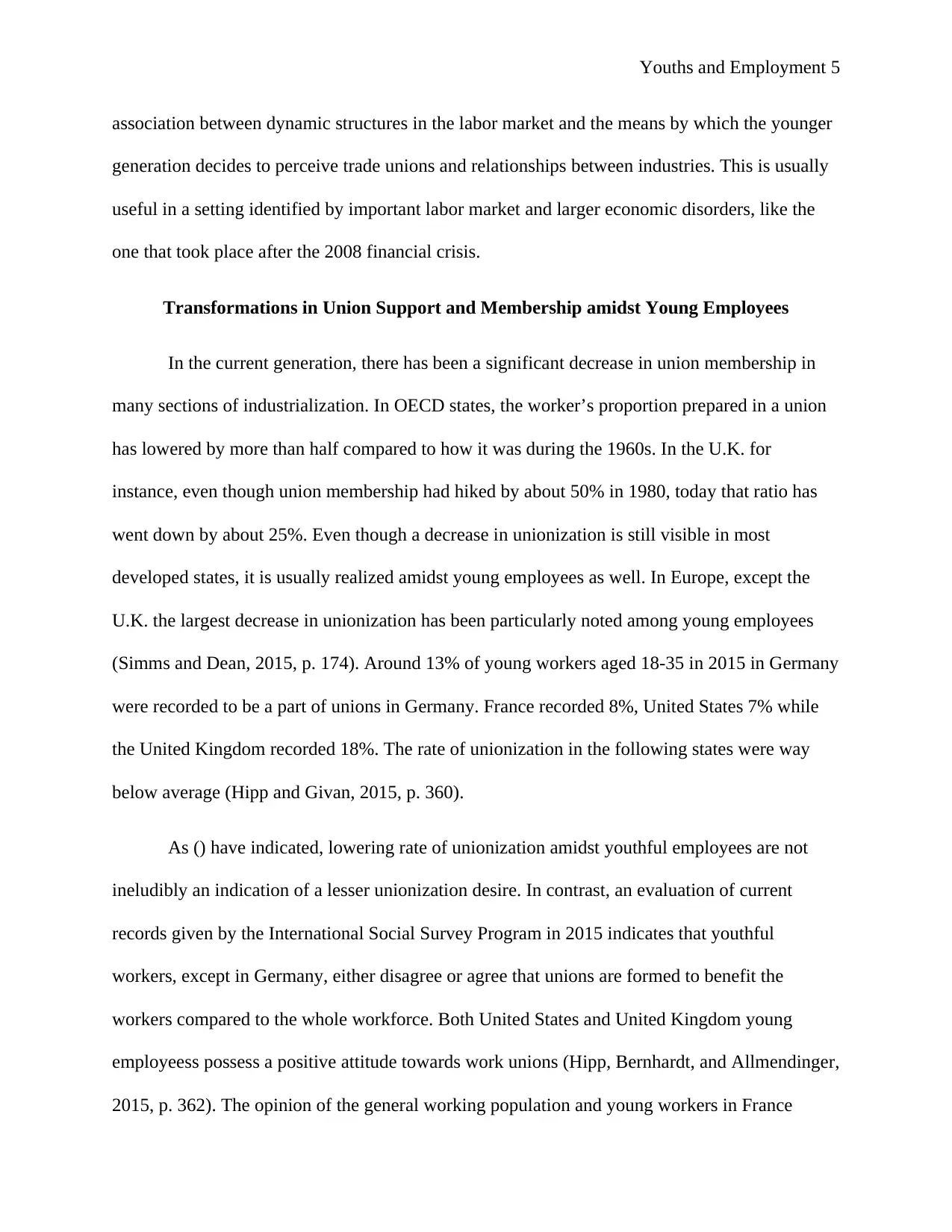
Youths and Employment 5
association between dynamic structures in the labor market and the means by which the younger
generation decides to perceive trade unions and relationships between industries. This is usually
useful in a setting identified by important labor market and larger economic disorders, like the
one that took place after the 2008 financial crisis.
Transformations in Union Support and Membership amidst Young Employees
In the current generation, there has been a significant decrease in union membership in
many sections of industrialization. In OECD states, the worker’s proportion prepared in a union
has lowered by more than half compared to how it was during the 1960s. In the U.K. for
instance, even though union membership had hiked by about 50% in 1980, today that ratio has
went down by about 25%. Even though a decrease in unionization is still visible in most
developed states, it is usually realized amidst young employees as well. In Europe, except the
U.K. the largest decrease in unionization has been particularly noted among young employees
(Simms and Dean, 2015, p. 174). Around 13% of young workers aged 18-35 in 2015 in Germany
were recorded to be a part of unions in Germany. France recorded 8%, United States 7% while
the United Kingdom recorded 18%. The rate of unionization in the following states were way
below average (Hipp and Givan, 2015, p. 360).
As () have indicated, lowering rate of unionization amidst youthful employees are not
ineludibly an indication of a lesser unionization desire. In contrast, an evaluation of current
records given by the International Social Survey Program in 2015 indicates that youthful
workers, except in Germany, either disagree or agree that unions are formed to benefit the
workers compared to the whole workforce. Both United States and United Kingdom young
employeess possess a positive attitude towards work unions (Hipp, Bernhardt, and Allmendinger,
2015, p. 362). The opinion of the general working population and young workers in France
association between dynamic structures in the labor market and the means by which the younger
generation decides to perceive trade unions and relationships between industries. This is usually
useful in a setting identified by important labor market and larger economic disorders, like the
one that took place after the 2008 financial crisis.
Transformations in Union Support and Membership amidst Young Employees
In the current generation, there has been a significant decrease in union membership in
many sections of industrialization. In OECD states, the worker’s proportion prepared in a union
has lowered by more than half compared to how it was during the 1960s. In the U.K. for
instance, even though union membership had hiked by about 50% in 1980, today that ratio has
went down by about 25%. Even though a decrease in unionization is still visible in most
developed states, it is usually realized amidst young employees as well. In Europe, except the
U.K. the largest decrease in unionization has been particularly noted among young employees
(Simms and Dean, 2015, p. 174). Around 13% of young workers aged 18-35 in 2015 in Germany
were recorded to be a part of unions in Germany. France recorded 8%, United States 7% while
the United Kingdom recorded 18%. The rate of unionization in the following states were way
below average (Hipp and Givan, 2015, p. 360).
As () have indicated, lowering rate of unionization amidst youthful employees are not
ineludibly an indication of a lesser unionization desire. In contrast, an evaluation of current
records given by the International Social Survey Program in 2015 indicates that youthful
workers, except in Germany, either disagree or agree that unions are formed to benefit the
workers compared to the whole workforce. Both United States and United Kingdom young
employeess possess a positive attitude towards work unions (Hipp, Bernhardt, and Allmendinger,
2015, p. 362). The opinion of the general working population and young workers in France
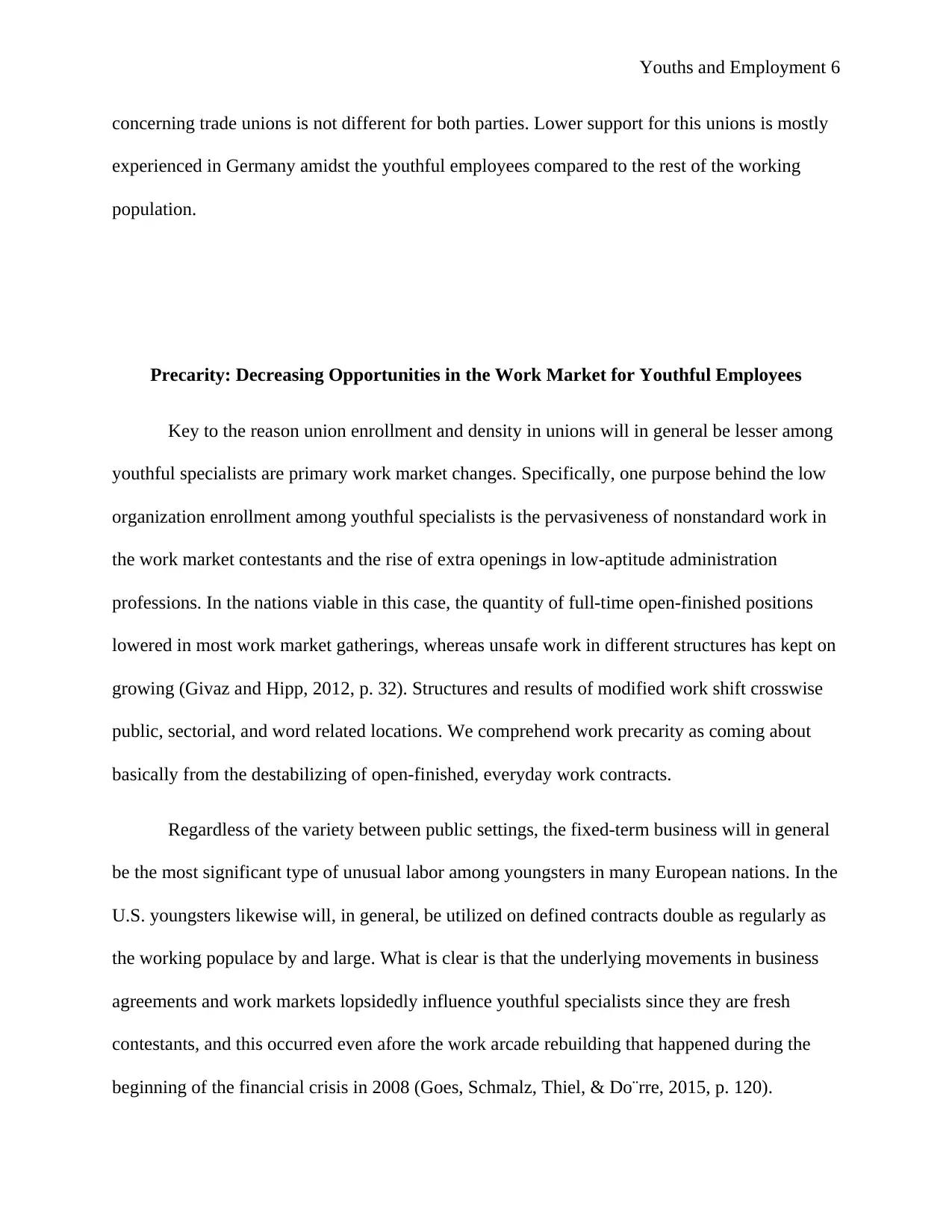
Youths and Employment 6
concerning trade unions is not different for both parties. Lower support for this unions is mostly
experienced in Germany amidst the youthful employees compared to the rest of the working
population.
Precarity: Decreasing Opportunities in the Work Market for Youthful Employees
Key to the reason union enrollment and density in unions will in general be lesser among
youthful specialists are primary work market changes. Specifically, one purpose behind the low
organization enrollment among youthful specialists is the pervasiveness of nonstandard work in
the work market contestants and the rise of extra openings in low-aptitude administration
professions. In the nations viable in this case, the quantity of full-time open-finished positions
lowered in most work market gatherings, whereas unsafe work in different structures has kept on
growing (Givaz and Hipp, 2012, p. 32). Structures and results of modified work shift crosswise
public, sectorial, and word related locations. We comprehend work precarity as coming about
basically from the destabilizing of open-finished, everyday work contracts.
Regardless of the variety between public settings, the fixed-term business will in general
be the most significant type of unusual labor among youngsters in many European nations. In the
U.S. youngsters likewise will, in general, be utilized on defined contracts double as regularly as
the working populace by and large. What is clear is that the underlying movements in business
agreements and work markets lopsidedly influence youthful specialists since they are fresh
contestants, and this occurred even afore the work arcade rebuilding that happened during the
beginning of the financial crisis in 2008 (Goes, Schmalz, Thiel, & Do¨rre, 2015, p. 120).
concerning trade unions is not different for both parties. Lower support for this unions is mostly
experienced in Germany amidst the youthful employees compared to the rest of the working
population.
Precarity: Decreasing Opportunities in the Work Market for Youthful Employees
Key to the reason union enrollment and density in unions will in general be lesser among
youthful specialists are primary work market changes. Specifically, one purpose behind the low
organization enrollment among youthful specialists is the pervasiveness of nonstandard work in
the work market contestants and the rise of extra openings in low-aptitude administration
professions. In the nations viable in this case, the quantity of full-time open-finished positions
lowered in most work market gatherings, whereas unsafe work in different structures has kept on
growing (Givaz and Hipp, 2012, p. 32). Structures and results of modified work shift crosswise
public, sectorial, and word related locations. We comprehend work precarity as coming about
basically from the destabilizing of open-finished, everyday work contracts.
Regardless of the variety between public settings, the fixed-term business will in general
be the most significant type of unusual labor among youngsters in many European nations. In the
U.S. youngsters likewise will, in general, be utilized on defined contracts double as regularly as
the working populace by and large. What is clear is that the underlying movements in business
agreements and work markets lopsidedly influence youthful specialists since they are fresh
contestants, and this occurred even afore the work arcade rebuilding that happened during the
beginning of the financial crisis in 2008 (Goes, Schmalz, Thiel, & Do¨rre, 2015, p. 120).
⊘ This is a preview!⊘
Do you want full access?
Subscribe today to unlock all pages.

Trusted by 1+ million students worldwide

Youths and Employment 7
Therefore, the fruitful youthful specialists entering the work force undergo far more serious
dangers of the present moment and adaptable work than ongoing ages. Notwithstanding the
development in unsafe business and the connected precarity, it definitely conveys to more
extensive public activity, the issue of financial security and employment soundness is of
fundamental significance to youthful specialists. Not exclusively is smooth progress from
university to business linked to upcoming word related achievement, the possibility of
possessing a safe workplace is likewise abstractly significant.
In a survey carried out recently on young workers work orientation, Germany, France and
United States and the United Kingdom indicated that it is quite important for them to secure a
job position. However, when most of these people were questioned if they felt that they were
secure in their work positions, a third of them only below 33 years of age based in United
Kingdom and France and 40% in the United States and Germany confirmed that they felt that
their job positions were secure (Furlong et al., 2017, p. 29). Being a member of a union and
paying for membership fees is usually not appealing to youthful workers found in the labor
market who usually stay for a long period before landing a decent work position and most are
usually temporarily employed and they might not feel completely secure in their job positions.
Membership in unions is usually dominated by the older society who are more experienced and
skilled and it is usually hard for the younger generation to join this unions. The union members
are usually protected from losing their jobs and receiving low salaries compared to other workers
who are usually the young people who have low skills set and who possess less experience in the
job market. This makes young people to detest unions as they feel that most of these unions are
not concerned with their wellbeing and they have to wait till they are older enough to join these
unions.
Therefore, the fruitful youthful specialists entering the work force undergo far more serious
dangers of the present moment and adaptable work than ongoing ages. Notwithstanding the
development in unsafe business and the connected precarity, it definitely conveys to more
extensive public activity, the issue of financial security and employment soundness is of
fundamental significance to youthful specialists. Not exclusively is smooth progress from
university to business linked to upcoming word related achievement, the possibility of
possessing a safe workplace is likewise abstractly significant.
In a survey carried out recently on young workers work orientation, Germany, France and
United States and the United Kingdom indicated that it is quite important for them to secure a
job position. However, when most of these people were questioned if they felt that they were
secure in their work positions, a third of them only below 33 years of age based in United
Kingdom and France and 40% in the United States and Germany confirmed that they felt that
their job positions were secure (Furlong et al., 2017, p. 29). Being a member of a union and
paying for membership fees is usually not appealing to youthful workers found in the labor
market who usually stay for a long period before landing a decent work position and most are
usually temporarily employed and they might not feel completely secure in their job positions.
Membership in unions is usually dominated by the older society who are more experienced and
skilled and it is usually hard for the younger generation to join this unions. The union members
are usually protected from losing their jobs and receiving low salaries compared to other workers
who are usually the young people who have low skills set and who possess less experience in the
job market. This makes young people to detest unions as they feel that most of these unions are
not concerned with their wellbeing and they have to wait till they are older enough to join these
unions.
Paraphrase This Document
Need a fresh take? Get an instant paraphrase of this document with our AI Paraphraser

Youths and Employment 8
Measures to Address Youth Unemployment
The need to address the issue of unemployment among youths have become a global
issues. There are policies that have been implemented in many states in an attempt to ensure that
youths are included in the job market in many states. To make the necessary changes, one of the
main stakeholder to initiate change is the government. Youths interests should be included in
most unions to encourage youths to join unions and be active members just like the older
generation (Vandaele, 2012, p. 207). This means that the unions should ensure that young
workers are protected in their job positions and their interests covered in their work guidelines.
One of the best way to help the youths is by initiating employment based approaches.
Employment based approaches indicate the decrease in membership by young people in
regard to their employment conditions and the insufficiencies that unions at their work places fail
to address. Usually, trade unions are weak in private sectors since they are a bit smaller
compared to public sectors. This means that youthful workers might find themselves working in
areas that are not covered by trade unions which might mean that trade unions fail to cover their
interests. This is one problem that trade unions should cover to ensure that youths employed in
all sectors regardless of whether they are public or private are covered in their regulations
(Simms, Holgate, & Hodder, 2017, p.12). This will not only ensure that youths are not mistreated
in their workplaces but it will also ensure that the youths are motivated to join the trade unions
but it will also ensure that there are plenty of employment opportunities for youths.
Even though the older generation have a high level of experience in their work field, the
youths have more skills since they have been updated with the current skills in the market. This
means that the youths make a crucial addition to the job market as they are not only mentored by
the older generation, they can also mentor the older generation by showing them the current
Measures to Address Youth Unemployment
The need to address the issue of unemployment among youths have become a global
issues. There are policies that have been implemented in many states in an attempt to ensure that
youths are included in the job market in many states. To make the necessary changes, one of the
main stakeholder to initiate change is the government. Youths interests should be included in
most unions to encourage youths to join unions and be active members just like the older
generation (Vandaele, 2012, p. 207). This means that the unions should ensure that young
workers are protected in their job positions and their interests covered in their work guidelines.
One of the best way to help the youths is by initiating employment based approaches.
Employment based approaches indicate the decrease in membership by young people in
regard to their employment conditions and the insufficiencies that unions at their work places fail
to address. Usually, trade unions are weak in private sectors since they are a bit smaller
compared to public sectors. This means that youthful workers might find themselves working in
areas that are not covered by trade unions which might mean that trade unions fail to cover their
interests. This is one problem that trade unions should cover to ensure that youths employed in
all sectors regardless of whether they are public or private are covered in their regulations
(Simms, Holgate, & Hodder, 2017, p.12). This will not only ensure that youths are not mistreated
in their workplaces but it will also ensure that the youths are motivated to join the trade unions
but it will also ensure that there are plenty of employment opportunities for youths.
Even though the older generation have a high level of experience in their work field, the
youths have more skills since they have been updated with the current skills in the market. This
means that the youths make a crucial addition to the job market as they are not only mentored by
the older generation, they can also mentor the older generation by showing them the current
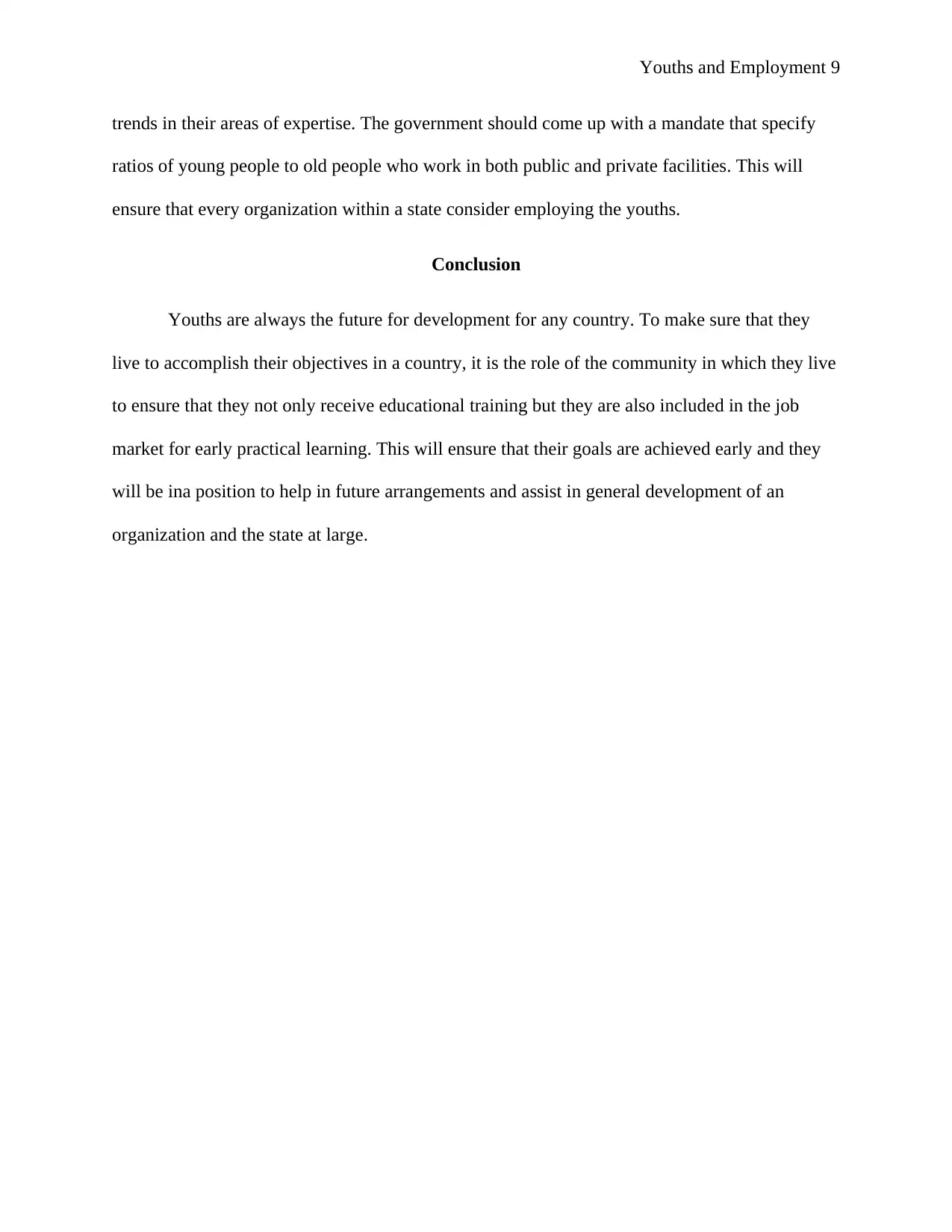
Youths and Employment 9
trends in their areas of expertise. The government should come up with a mandate that specify
ratios of young people to old people who work in both public and private facilities. This will
ensure that every organization within a state consider employing the youths.
Conclusion
Youths are always the future for development for any country. To make sure that they
live to accomplish their objectives in a country, it is the role of the community in which they live
to ensure that they not only receive educational training but they are also included in the job
market for early practical learning. This will ensure that their goals are achieved early and they
will be ina position to help in future arrangements and assist in general development of an
organization and the state at large.
trends in their areas of expertise. The government should come up with a mandate that specify
ratios of young people to old people who work in both public and private facilities. This will
ensure that every organization within a state consider employing the youths.
Conclusion
Youths are always the future for development for any country. To make sure that they
live to accomplish their objectives in a country, it is the role of the community in which they live
to ensure that they not only receive educational training but they are also included in the job
market for early practical learning. This will ensure that their goals are achieved early and they
will be ina position to help in future arrangements and assist in general development of an
organization and the state at large.
⊘ This is a preview!⊘
Do you want full access?
Subscribe today to unlock all pages.

Trusted by 1+ million students worldwide

Youths and Employment 10
References
Berry, C. and McDaniel, S., 2012. Post-crisis precarity: Understanding attitudes to work and
industrial relations among young people in the UK. Economic and Industrial Democracy,
p.0143831X19894380.
Furlong, A., Goodwin, J., O’Connor, H., Hadfield, S., Hall, S., Lowden, K., & Plugor, R. (2017).
Young people in the labour market: Past, present, future. London, England: Routledge.
Givan, R. K., & Hipp, L. (2012). Public perceptions of union efficacy: A twentyfour country
study. Labor Studies Journal, 37(1), 7–32.
Goes, T., Schmalz, S., Thiel, M., & Do¨rre, K. (2015). Gewerkschaften im Aufwind [Unions on
the upswing] (Vol. 83). Frankfurt a.M.:
Hipp, L., & Givan, R. K. (2015). What do unions do? A cross-national reexamination of the
relationship between unionization and job satisfaction. Social Forces, 94(1), 349–377.
Holgate J, Simms M and Hodder A. (2016) Young workers in the Bakers union: a case study of
the Fast Food Rights campaign. Available at j.holgate@ leeds.ac.uk
International Social Survey Programme. (2015a). Work orientations IV. Available at:
https://www.gesis.org/issp/modules/issp-modules-by-topic/ work-orientations/
References
Berry, C. and McDaniel, S., 2012. Post-crisis precarity: Understanding attitudes to work and
industrial relations among young people in the UK. Economic and Industrial Democracy,
p.0143831X19894380.
Furlong, A., Goodwin, J., O’Connor, H., Hadfield, S., Hall, S., Lowden, K., & Plugor, R. (2017).
Young people in the labour market: Past, present, future. London, England: Routledge.
Givan, R. K., & Hipp, L. (2012). Public perceptions of union efficacy: A twentyfour country
study. Labor Studies Journal, 37(1), 7–32.
Goes, T., Schmalz, S., Thiel, M., & Do¨rre, K. (2015). Gewerkschaften im Aufwind [Unions on
the upswing] (Vol. 83). Frankfurt a.M.:
Hipp, L., & Givan, R. K. (2015). What do unions do? A cross-national reexamination of the
relationship between unionization and job satisfaction. Social Forces, 94(1), 349–377.
Holgate J, Simms M and Hodder A. (2016) Young workers in the Bakers union: a case study of
the Fast Food Rights campaign. Available at j.holgate@ leeds.ac.uk
International Social Survey Programme. (2015a). Work orientations IV. Available at:
https://www.gesis.org/issp/modules/issp-modules-by-topic/ work-orientations/
Paraphrase This Document
Need a fresh take? Get an instant paraphrase of this document with our AI Paraphraser
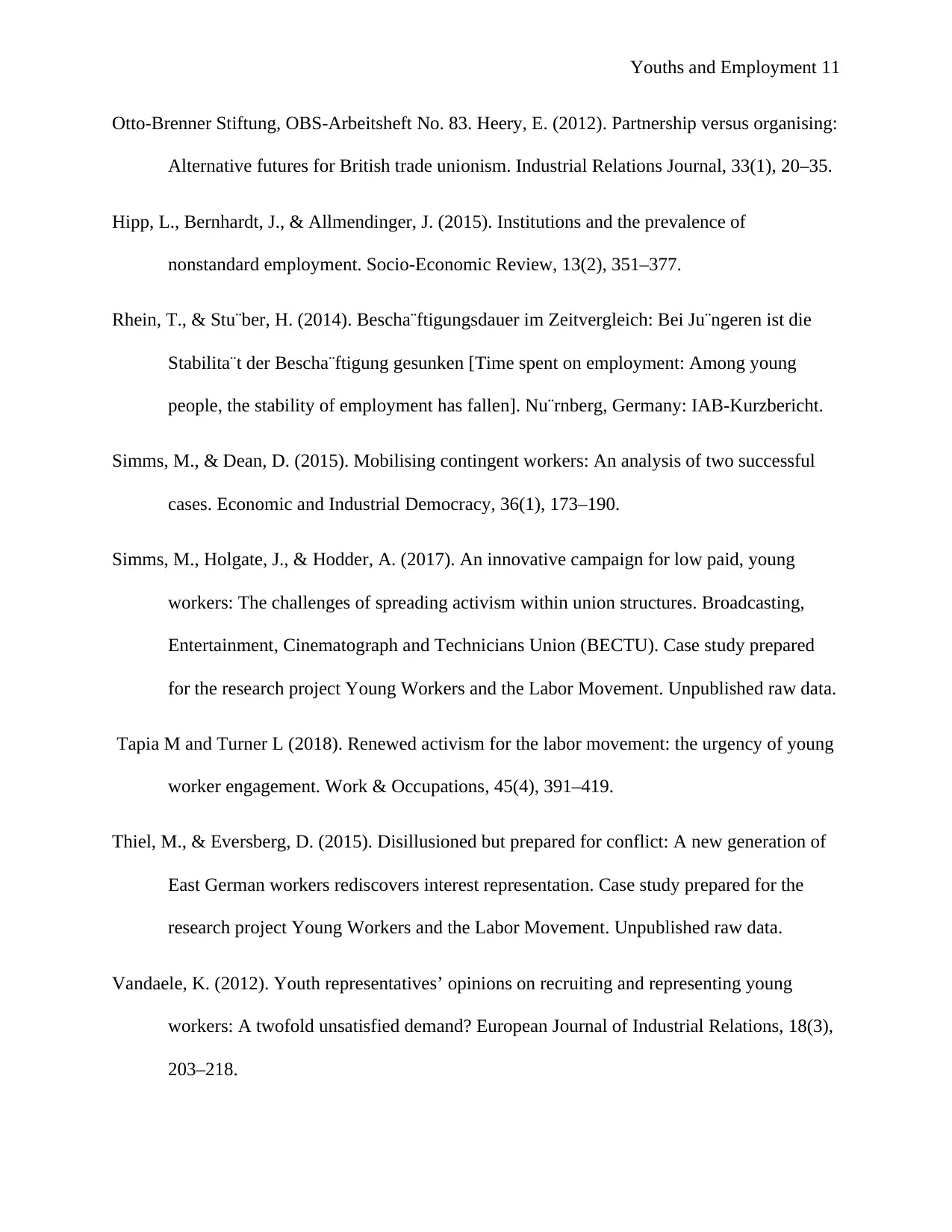
Youths and Employment 11
Otto-Brenner Stiftung, OBS-Arbeitsheft No. 83. Heery, E. (2012). Partnership versus organising:
Alternative futures for British trade unionism. Industrial Relations Journal, 33(1), 20–35.
Hipp, L., Bernhardt, J., & Allmendinger, J. (2015). Institutions and the prevalence of
nonstandard employment. Socio-Economic Review, 13(2), 351–377.
Rhein, T., & Stu¨ber, H. (2014). Bescha¨ftigungsdauer im Zeitvergleich: Bei Ju¨ngeren ist die
Stabilita¨t der Bescha¨ftigung gesunken [Time spent on employment: Among young
people, the stability of employment has fallen]. Nu¨rnberg, Germany: IAB-Kurzbericht.
Simms, M., & Dean, D. (2015). Mobilising contingent workers: An analysis of two successful
cases. Economic and Industrial Democracy, 36(1), 173–190.
Simms, M., Holgate, J., & Hodder, A. (2017). An innovative campaign for low paid, young
workers: The challenges of spreading activism within union structures. Broadcasting,
Entertainment, Cinematograph and Technicians Union (BECTU). Case study prepared
for the research project Young Workers and the Labor Movement. Unpublished raw data.
Tapia M and Turner L (2018). Renewed activism for the labor movement: the urgency of young
worker engagement. Work & Occupations, 45(4), 391–419.
Thiel, M., & Eversberg, D. (2015). Disillusioned but prepared for conflict: A new generation of
East German workers rediscovers interest representation. Case study prepared for the
research project Young Workers and the Labor Movement. Unpublished raw data.
Vandaele, K. (2012). Youth representatives’ opinions on recruiting and representing young
workers: A twofold unsatisfied demand? European Journal of Industrial Relations, 18(3),
203–218.
Otto-Brenner Stiftung, OBS-Arbeitsheft No. 83. Heery, E. (2012). Partnership versus organising:
Alternative futures for British trade unionism. Industrial Relations Journal, 33(1), 20–35.
Hipp, L., Bernhardt, J., & Allmendinger, J. (2015). Institutions and the prevalence of
nonstandard employment. Socio-Economic Review, 13(2), 351–377.
Rhein, T., & Stu¨ber, H. (2014). Bescha¨ftigungsdauer im Zeitvergleich: Bei Ju¨ngeren ist die
Stabilita¨t der Bescha¨ftigung gesunken [Time spent on employment: Among young
people, the stability of employment has fallen]. Nu¨rnberg, Germany: IAB-Kurzbericht.
Simms, M., & Dean, D. (2015). Mobilising contingent workers: An analysis of two successful
cases. Economic and Industrial Democracy, 36(1), 173–190.
Simms, M., Holgate, J., & Hodder, A. (2017). An innovative campaign for low paid, young
workers: The challenges of spreading activism within union structures. Broadcasting,
Entertainment, Cinematograph and Technicians Union (BECTU). Case study prepared
for the research project Young Workers and the Labor Movement. Unpublished raw data.
Tapia M and Turner L (2018). Renewed activism for the labor movement: the urgency of young
worker engagement. Work & Occupations, 45(4), 391–419.
Thiel, M., & Eversberg, D. (2015). Disillusioned but prepared for conflict: A new generation of
East German workers rediscovers interest representation. Case study prepared for the
research project Young Workers and the Labor Movement. Unpublished raw data.
Vandaele, K. (2012). Youth representatives’ opinions on recruiting and representing young
workers: A twofold unsatisfied demand? European Journal of Industrial Relations, 18(3),
203–218.

Youths and Employment 12
⊘ This is a preview!⊘
Do you want full access?
Subscribe today to unlock all pages.

Trusted by 1+ million students worldwide
1 out of 12
Your All-in-One AI-Powered Toolkit for Academic Success.
+13062052269
info@desklib.com
Available 24*7 on WhatsApp / Email
![[object Object]](/_next/static/media/star-bottom.7253800d.svg)
Unlock your academic potential
Copyright © 2020–2025 A2Z Services. All Rights Reserved. Developed and managed by ZUCOL.